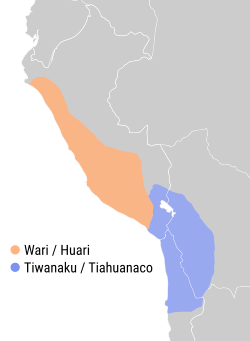Wari Empire facts for kids
Quick facts for kids
Wari Empire
|
|||||||||||||||
|---|---|---|---|---|---|---|---|---|---|---|---|---|---|---|---|
| 6th century–11th century | |||||||||||||||

Expansion and area of cultural influence.
|
|||||||||||||||
| Capital | Huari | ||||||||||||||
| Common languages | Aymara?, others. | ||||||||||||||
| Religion | Staff God | ||||||||||||||
| Historical era | Middle Horizon | ||||||||||||||
|
• Established
|
6th century | ||||||||||||||
|
• Disestablished
|
11th century | ||||||||||||||
|
|||||||||||||||
| Today part of | Peru | ||||||||||||||
The Wari Empire or Huari Empire was a powerful civilization. It started around 600 AD in the Ayacucho region of Peru. This empire grew to cover a large part of Peru's coast and highlands.
The Wari Empire lasted for about 500 years, until 1100 AD. It existed at the same time as the Tiwanaku culture. For a while, people thought the Wari came from the Tiwanaku. In 2008, archeologists found a pre-Columbian city. This city, called the Northern Wari ruins or Cerro Pátapo, was near modern Chiclayo. It was the first big Wari city found so far north.
Contents
Was the Wari a True Empire?
Some experts wonder if the Wari communities were truly an "empire." For example, the archeologist Ruth Shady thinks it might have been a group of Wari cities. These cities were connected by trade and shared ideas.
However, other experts like William Isbell, Katherine Schreiber, and Luis Lumbreras believe it was a true empire. They point to several things that show this. The Wari built a huge network of roads. These roads connected their main cities to smaller ones.
They also built special and grand buildings in their major centers. Some of these centers were very large. To build such big projects, Wari leaders had to plan carefully. They also had to organize many people to work.
In 2013, a royal tomb was found at El Castillo de Huarmey. This tomb had not been touched. It showed how rich and powerful the Wari were for hundreds of years. Inside, archeologists found the bodies of three royal women. They also found many valuable items and 60 other bodies buried with them. This discovery proves the Wari had great wealth and power. They also had a system to honor their royal dead for a long time.
How the Wari Empire Expanded and Ruled
The Wari Empire was one of the second major states in the Andean region. Before the Wari and Tiwanaku, the Moche state was the first big power. When the Wari Empire grew, it had a smart way of taking over new areas. They let the local leaders stay in charge of their land. This happened if the leaders agreed to join the Wari empire and obey its rules.
The Wari also asked their people for a type of public work called mit'a labor. This was a way for people to pay tribute to the state. People doing mit'a labor helped build structures in the Wari capital city. They also worked on buildings in other Wari cities.
The Wari Empire and the Tiwanaku empire were like two powerful neighbors. Archeologist Joyce Marcus compared their relationship to the United States and the Soviet Union during the Cold War. They did not fight each other because they feared what would happen. The two empires met in a place called Moquegua. Here, Wari and Tiwanaku people lived side-by-side without fighting.
Wari Administration and Collapse
The Wari likely had strong ways of organizing and managing their empire. But it's not fully clear where their political and artistic ideas came from. New evidence suggests that Wari and Tiwanaku ideas did not just spread from one to the other. Instead, both might have gotten their ideas from earlier cultures. One such culture was Pukara, which existed north of Lake Titicaca.
The Wari Empire lasted until about 1100 AD. It then collapsed. This likely happened because of changes in the environment. Also, problems within their society and government probably played a part.
See also
 In Spanish: Imperio Wari para niños
In Spanish: Imperio Wari para niños

